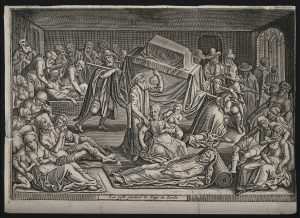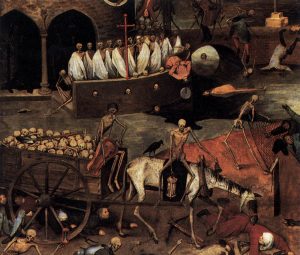“Bring out your dead!” When one thinks of the Black Death, they usually picture the iconic scene in Monty Python and the Holy Grail where the bodies are collected from the houses of the poor. The body collectors weave through tightly-knit towns, stacking up corpses on their cart—and some were still alive! This popular image depicts the assumed poor hygiene and lack of proper sewage in the closely-knit, rat-infested towns of the Middle Ages, but it may be time to frame the plague’s spread in a different light. By evaluating the laws that mandated the width of the streets, looking at documents regarding city planning and the consideration of routes for sewage and waste, and looking at the money spent on maintaining the city’s cleanliness, one finds substantial evidence that the plague’s spread is not to be blamed solely on any “dirty, unhygienic” peasants.
So, how did medieval administrators deal with “public health,” sanitation, and the arrival of the plague? Administrators did not just sit back and allow their cities to become infected with the plague. In fact, they took action to prevent it from spreading by passing various ordinations, regulations, and laws in accordance to complaints made by the inhabitants. People living in the cities noticed when their neighborhoods began to reek of waste, whether human or animal waste, or a mixture of both. They took their complaints directly to the King, who in turn ordered mayors and sheriffs to clean up their cities. Historian Dolly Jorgenson points out that, to the medieval person, “smell was not a private matter, but a public concern; it became a transgression of private space and personal boundaries.” When people felt that their personal spaces were being invaded with infected air, it is only natural that they would protest and demand that something was to be done about it.

During the plague itself, the belief that the air was corrupted was likely only strengthened by putrid scents of rotting animal entrails, corpses, and an overflow of human waste. Before the plague hit, Europe was experiencing its largest population boom yet, and therefore the cities were handling more waste of all types than they ever had. Action was already taken in various cities to keep them clean before the plague even hit. For example, in 1332, King Edward III described the awful stench of York due to an excessive amount of dung and manure, which in his mind was dangerous to the inhabitants and visitors to the city. Edward III had similar remarks about Oxford in 1338, but instead he narrowed down the stench there to rotting animal flesh and hides. He ordered the government of each city to clean up the streets because the odor was linked to illness and infection, so particular sanitation methods were required to control the stench and cleanliness.
Much like modern day sewers, a lot of waste was thought to be “out of sight, out of mind” once carried away by water in the streets. Gutters were added into many cities to take away excessive rainwater, but people assumed they could throw waste in there along with the water and forget about it. However, the gutters led into local rivers, which eventually would become blocked with waste and infect the water. This further pushed medieval people to make a connection between the plague and the elements, nature, and their surroundings. The stench of corrupt water and air was impossible for people to ignore before the plague; hence the various ordinances put in place to clean up the cities.

Naturally, that stench continued to be a problem since there were many sanitation acts passed in the decades directly following the plague, such as when King Edward III ordered the government of Gloucester to keep an area by the castle door cleared for dung heaps in 1372. The influx of administrative actions for city cleanliness and proper waste disposal following the plague makes it clear that some people believed the plague could return due to a dirty, waste-filled environment. The upkeep of public health had always been important to medieval people, which directly opposes the stereotypical image in modern minds of medieval cities being dirty places.
However, the way the Black Death is taught and talked about seems to have barely changed at all, at least at the most basic levels of education. After all, my perception of the plague had always been that it was an epidemic that spread thanks to the dirty cities and the lack of proper hygiene and modern medicine. In fact, the plague was so impactful due to all sorts of factors lined up at the perfect time. The great famine of the early 14th century weakened bodies, the population rose to a height it never had before (which caused the overcrowded cities), and a lack of technology to study the disease all contributed greatly to the plague’s disastrous outcome. It is necessary for all of us—myself included—to change the way we talk about the plague by digging deeper into the issue and assuming the same kind of complexity observable in contemporary disasters that happen all around us.